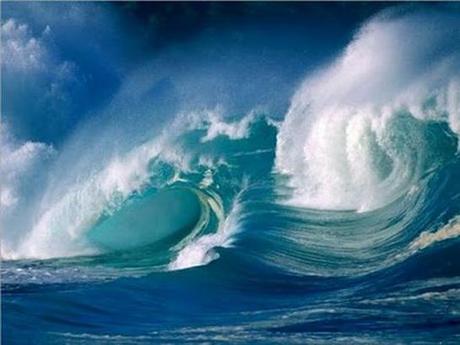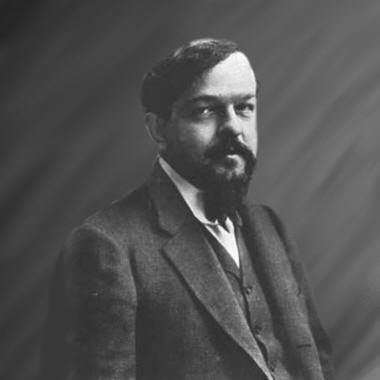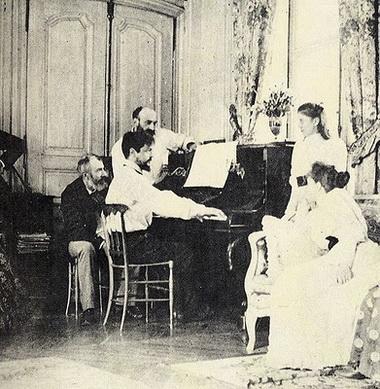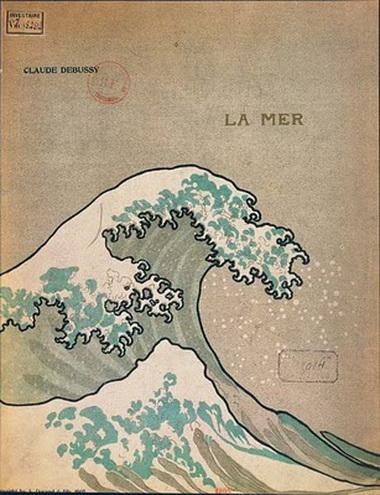
Claude Debussy [1862-1918] occupies a crucial position in the history of the development of musical styles. Trained in the academic French tradition, he broke away from the formalist expectations of his contemporaries to create a strong, personal style, characterized by an impressionistic, subtle palette of colors and orchestral effects. He composed for a number of different combinations of instruments, but his instrument was the piano. His major work for orchestra is undoubtedly La Mer [1903-1905], the quintessential musical monument to Impressionism. Classical music in the late 19th Century was bound by preconceived notions of musical form. The classical sonata format, adapted to the increasingly lush, expansive, ambitious Romantic symphony, dictated that serious music be composed in tight, triadic groups–exposition, development and recapitulation. The Romantic composers frequently added a fourth movement, usually between the second and third parts, a kind of recess or recreation, before the serious finality of the ultimate section. This strict ordering dictated that musical ideas be formulated in a fairly rigid manner. A composer was expected to state his theme, develop it, and then present a kind of ultimate transformative sublimation–a cathartic journey from resolution to meditation (or questioning, or wandering) to conviction (or truth). This conceptual frame was a very powerful tool throughout the Classical and Romantic periods of music, but by the end of the 19th Century, certain musical minds (such as Debussy and Satie) were beginning to chafe under the regnant domination of this code of acceptable practice.

There were allied developments in the other arts, of course. In painting, representation was being questioned, and manipulated (Cezanne, Monet, Picasso). In literature, the Symbolists were transforming poetic doctrine (Baudelaire, Verlaine). In popular design and architecture, Arts & Crafts and Art Nouveau were in vogue. Freud and James were delving into human behavior and the Unconscious. Henri Bergson [1859-1941] was theorizing a dynamic creativity, unhindered by the restraints of time and space.
Debussy’s early works are notable for their delicacy and sweet or tart lyricism. He did not essay larger, more ambitious forms until his mid-thirties, when he completed the three Nocturnes [1899] for orchestra,* his only opera, Pelléas et Mélisande [1902], and La Mer [1905]. These new works challenged both the structural constraints of the classical tradition, and the harmonic techniques perpetuated by the Viennese School of composition. He found inspiration in the work of Russian composers, such as Rimsky-Korsakov, Borodin, Mussorgsky, Tchaikovsky, Balakirev. From them, came an “oriental” exoticism and faux ancien mystical quality, which would find their way into his mature work.

The other primary innovation in La Mer is its programmatic element. Music composed for the opera, the dance, or for café society or sheer popular entertainment, was distinguished from “pure” music, that is, music composed within the formalist traditions growing out of patronage and the classical orders of serious, concert-hall, or chamber performance. La Mer challenges all these presumptions, building up sound impressionistically, rather than through the formulaic procedures used by, for instance, Brahms, or Saint-Saens. Sheherazade [Rimsky-Korsakov, 1888], Pictures at an Exhibition [Mussorgsky, 1874], The Nutcracker [Tchaikovsky, 1892], the Polovetsian Dances [Borodin, 1890] each prefigures impressionistic use and meaning through spontaneous orchestral effects, nativistic thematic material, and impressionistic technique. Adapting these examples, Debussy contributed his own crisp, refined French personality, to produce the works upon which his popular reputation is based.

The cover of the sheet music for the score of La Mer: Three Symphonic Sketches [Durand]
La Mer, like many of Debussy’s compositions, is moodily romantic, wreathing tendrils of delicate melancholy and nostalgic longing around certain repeated figures. A typical performance of this piece lasts about 24 minutes. It is in three movements:
(~09:00) “De l’aube à midi sur la mer” – très lent (si mineur)
(~06:30) “Jeux de vagues” – allegro (do dièse mineur)
(~08:00) “Dialogue du vent et de la mer” – animé et tumultueux (do dièse mineur)
Usually translated as:
“From dawn to noon on the sea” or “From dawn to midday on the sea” – very slowly (B minor)
“Play of the waves” or “Play the waves” – allegro (C sharp minor)
“Dialogue of the wind and the sea” or “Dialogue between wind and waves” – animated and tumultuous (C sharp minor)
The work’s three-part structure suggests a symphonic arrangement, but the music is highly suggestive in ways that are not structural-driven. Sound grows out of the emotional progression of feeling, rather than out of a theme played within a rhythmic tempo. There is no mistaking the subtly “oceanic” or “wave-like” quality of many of its passages, but the gentle dissonant harmonies, its surprising annunciatory interjections, and rapid modulations of mood and pacing keep it from seeming monotonously progressive. Then there are effects of spray or swishing/dashing sounds, which punctuate the evocative, meditative ethereal streams of sound. Instruments in the orchestra become like the respective metaphorical forces of the natural world (wind, water, storm, flux) though without forming a narrative picture.

The work hovers between pure music, and an evocation of natural forces. Later composers–especially those working in the theatre, or in cinema, ransacked Debussy’s discoveries and inventions, to exploit the combinations and pacings which he employed to such miraculous effect. Obviously, furnishing photographs or paintings to suggest the qualities in a complex piece of music is a tawdry gesture. The best way to experience what I’ve been talking about here is to listen to the music yourself, which has become easy enough via YouTube@. I have several recordings of the work, but I’ve only heard it performed, once, by the French National Orchestra–wow, what a performance it was! One of their warhorses, certainly.

The Impressionists were masters at creating moods, sometimes exotic, sometimes familiar. Debussy himself resented being called an Impressionist, perhaps because the term tended to suggest a haze or cloud-like quality, a state of atomized randomness or mist. Actually, Debussy frequently employed mathematic concepts in his works, like the Golden Section. Can music, the most fluid and most deeply expressive of all the arts, be mathematically precise and emotionally effective at the same time?
Debussy once described Albeniz’s Iberian Suite for piano as a miraculous evocation of romantic thought, underscoring his interest in generating visionary, dream-like states, or idyllic exotic projections. A piece of music such as this can be like a conch shell that you hold up to your ear, the faraway “shhhhhhh” of distant shores, of the rolling almanac of sea voyages, both literal, and imaginative, to shores unseen, worlds yet unexplored.
__________________________________
La mer

